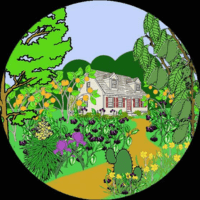Holly Oak Truffle Tree
Will Truffles grow from our Holly Oak, Quercus ilex? This webpage will show you how we do what we do, and if truffles grow. Join us!
Truffles grow underground. It’s like an underground mushroom. There are over 140 species of Truffles. However, only 2 species are grown commercially due to their reliability and quality: Black Perigord truffle (Tuber melanosporum); and Burgundy/Summer Truffle (Tuber aestivum).
Oak or Hazelnut are host trees. Truffles grow around the roots of the Oak or Hazelnut due to a symbiotic relationship within the roots. Only a few species of Oak (Quercus) and Hazelnut (Corylus) are used to inoculate. However, there are other, secondary host trees. Beech, Birch, Cedar, Hornbeam, Pine, Polar, and Willow can be cultivated as host trees to grow Truffles. Also, soil pH and drainage are BIG factors too.
Inoculation is when the Truffle spores are introduced to the Oak or Hazelnut host tree.
The webpage shares what we’ve learned those topic, resources and how we do what we do with Truffle Trees! Welcome to HEPPY™, and Join Us on YouTube!

Truffle Tree Plant Guide
Holly Oak (Quercus ilex) truffle tree, inoculated with truffle spores Tuber melanosporum
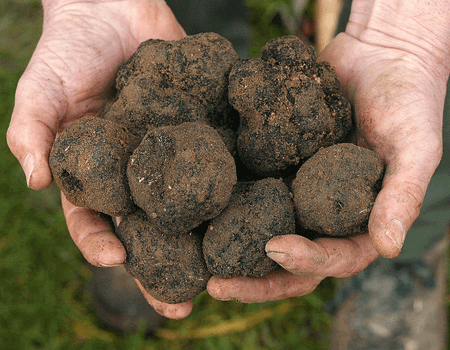
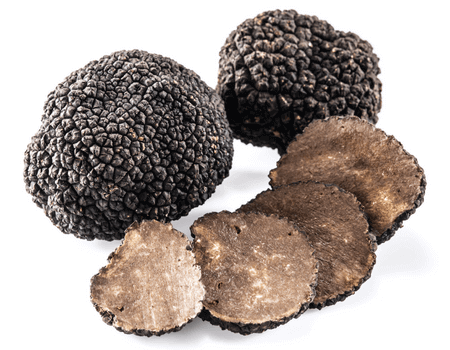
What's a Truffle and How Do They grow?
What's a Truffle
in simple terms, Truffles are a type of Fungi. they’re an underground mushroom (keeping it simple ;). Truffles belong to a group (phylum) commonly known as the sac fungi or ascomycetes. examples of ascomycetes include morels, truffles, brewers’ and bakers’ yeast, dead man’s fingers, and cup fungi. like mushrooms, they spread by spores and their development & life cycles are complicated (for my brain). finally, Truffles are a ectomycorrhizal fungi. they cannot survive in soil without attaching to the roots of a host tree (more about that below).
historically, Truffles were first mentioned 4,000 years ago. the neo-Sumerians described the eating habits of their enemy, the Amorite. then, several hundred years ago, Truffles gained popularity with kings & nobles and here we are — a fungi that sells for $700 to $1,200 per pound (the price of the most expensive Truffle, the Black Truffle).
regions in Spain, France, Italy, and Croatia are the natural habitat of the Black Truffle (Tuber melanosporum). Black Truffles are now cultivated in Australia, Europe, New Zealand, North America, South America, South Africa, and Wales.
Truffle development
Truffles develop mycelia — a root-like structure of fungus (mycelia is the mass of white, branching & thread-like structures you see when picking up rotted wood or woodchips). the truffles’ mycelia form a symbiotic, mycorrhizal relationship with the roots of several tree species. tree species include beech, birch, hazelnut, hornbeam, oak, pine, and poplar.
Black Truffles grow as an ectomycorrhizae: a form of symbiotic relationship that occurs between it (a fungal symbiont or mycobiont) and the roots of various plant species. the relationship is SO symbiotic that Truffles provide valuable nutrients to host trees in exchange for sugar and other carbohydrates! Truffles cannot survive in soil without attaching to the roots of a host tree.
so, Truffle mycelia gather nutrients from the soil, attach to the roots of host trees, obtain food (carbohydrates) from the host tree and deliver nutrients back to the tree. if the soil pH, moisture level, drainage & porosity are adaquate, a round, dark brown fruiting bodies (ascocarps) will develop. and that’s a Truffle!
Truffle species
there are over 140 species of Truffles. however, few species have market value and are cultivated.
common varieties include:
Black Perigord Truffle (Tuber melanosporum)
Winter Truffle (Tuber brumale)
Burgundy & Summer Truffle (Tuber aestivum)
Bianchetto Truffle (Tuber borchii)
Oregon White Truffle (Tuber oregonense/Tuber gibbosum)
This page is being written now in
August – October, 2023





Truffle harvest
description of Truffles include having the fragrance of cheese, garlic and fruit.
Cultivation involves the planting of, for example, hazel trees whose roots are inoculated with truffle mycelium. The first fruiting bodies can be harvested about 4-10 years after planting the trees.[24]
Truffles in culinary use
Truffle fruit is described as having the fragrance of cheese, garlic and fruit. the fruit’s composition infuses well with fats such as olive oil, butter, cream, cheeses, avocados, and coconut cream. it’s also added as an infusion to alcohol such as vodka.
Cultivation involves the planting of, for example, hazel trees whose roots are inoculated with truffle mycelium. The first fruiting bodies can be harvested about 4-10 years after planting the trees.[24]
Truffle recipes
description of Truffles include having the fragrance of cheese, garlic and fruit.
https://www.sabatinotruffles.com/blogs/recipes
Oak & Hazelnut, and other host trees
for Black Truffles (Tuber melanosporum), the primary host trees are Oak and Hazelnut. secondary trees are Beech, Birch, Cedar, Hornbeam, Pine, Polar, and Willow. for Bianchetto Truffles (Tuber borchii) and Burgundy & Summer Truffles (Tuber aestivum), replace Hazelnut with Pines as the primary host trees.
i’m not clear as to why Oak are the preferred tree EXCEPT that Oaks are long-lived, and largely pest & disease free. they may be the host tree with the longest lifespan. all together, Oak have the best attributes (as best as I can tell). if Hazelnut trees are selected, they should be a cultivar that’s resistant to Eastern Filbert Blight.
Holly Oak (Quercus ilex)
we purchased Truffle-inoculated trees from One Green World (OGW). we trust their plants and information. also, HEPPY is zone 7. so we selected Holly Oak (Quercus ilex) over the other option, the English Oak (Quercus robur).
Holly Oak are also called Holm Oak. it’s an evergreen, native to the Mediterranean. it grows 40 to 70 feet, but can be used as a hedge. it tolerates part shade but prefers full sun, and Holly Oak is drought resistant once established. OGW and the Missouri Botanical Garden rate the plant zone as 7 (7 is the coldest; likely to grow well in hot temperatures such as zone 10).
subsequent reading found that “significant damage occurs from the cold in Zone 7 in some years [and that Quercus ilex is] best suited for Zones 8 and warmer” Carolina Truffières.
in our first winter, our two Quercus ilex have sustained leaf burn from cold weather. Carolina Truffières recommends the sub-species, Roundleaf Holly Oak (Quercus ilex ssp. rotundifolia). however, i don’t see it commonly sold.
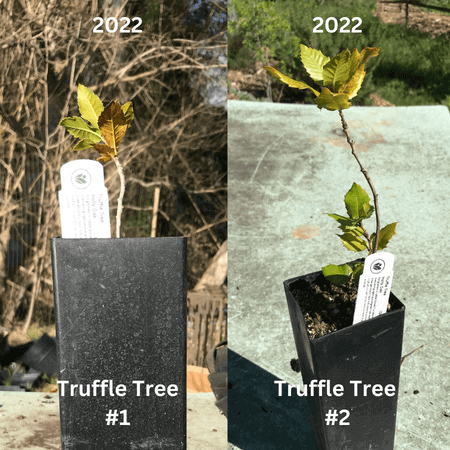
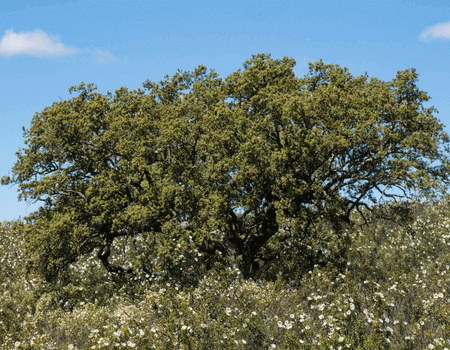

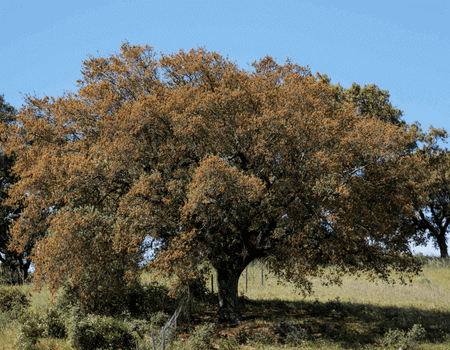
This page is being written now in
August – October, 2023
Franklinia Tea?
1 HEPPY cannot take any responsibility for any adverse effects from the use of plants. Always seek advice from a professional before using a plant for food or medicinally. This information is intended for educational purposes only and should not be considered as a recommendation or an endorsement of any particular medical or health treatment.
Edible Landscaping’s Michael McConkey mentioned that Franklinia alatamaha was used at tea in West Virginia. how Franklinia was abundant in WV is another topic :).
i researched the topic. Dr. Hassan Amjad of Beckley, West Virginia extensively researched Franklinia! Dr. Amjad was a medical doctor (geriatrician). he was described as a “genius, a healer, a tea enthusiast and an advocate.”
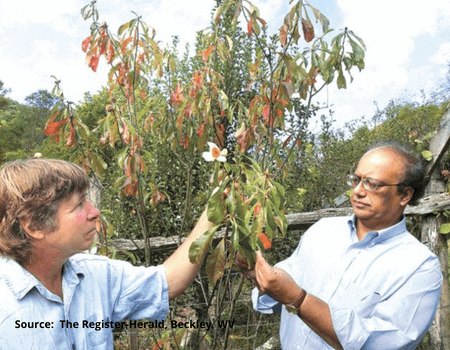
Clinical Research
Dr. Hassan Amjad’s conclusion is that “Franklinia alatamha has compounds similar to green tea, Camellia sinensis. Therefore, we expect to see the same medicinal benefits that green tea offers.” see The Society for Economic Botany (SEB) presentation on YouTube. Franklinia alatamha, An American Medicinal Tea Plant.
the relationship to Green Tea (Camellia sinesis) is important. Green Tea is “widely known for its anticancer and anti-inflammatory properties.” and, catechins are the “main antioxidant agents” in Green Tea, Camellia sinesis.
Green tea catechins are widely described to be efficient in the prevention of lung cancer, breast cancer, esophageal cancer, stomach cancer, liver cancer and prostate cancer (NIH / PubMed, Beneficial Properties of Green Tea Catechins).
catechins include epicatechin (EC), epicatechin gallate (ECG), epigallocatechin (EGC) and its stereoisomer gallocatechin (GC), epigallocatechin gallate (EGCG) and its stereoisomer gallocatechin gallate (GCG), with their compositions being similar for each other (NIH / PubMed, Catechins and Their Therapeutic Benefits to Inflammatory Bowel Disease).
Analysis of Franklinia leaves
Dr. Amjad found that Franklinia alatamaha leaves contained Catechins (0.35%), Epicatechins (0.51%), Epigallocatechins(0.33%), Epigallocatechin Gallate (0.1%), caffeine (0.18%), theophylline (0.02%), Theobromine (0.006%), Theoflavin (0.05%).
that’s how Dr. Amjad concluded that “F. alatamha has compounds similar to green tea, Camellia sinensis.”
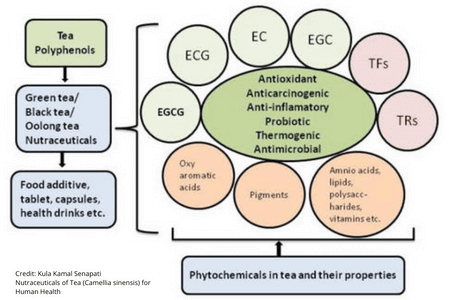
Franklinia Flowers
its flowers are special. it’s 3″ large and sweetly-fragrant flowers contrast beautifully with it’s lush green foliage. flowers are sweetly-fragrance and cup shaped.
the John Bartram Association writes,
“The flowers are numerous, and although each lasts only a day, at the peak of flowering the plant is covered day after day with blooms, often continuing for months until frost.”
Fall colors
Fall colors include shades of orange, maroon, burgundy, purple, lavender and red, including bright red.
Shape
they develop an rounded crown. single-trunk trees have a tendency to grow tallest (20 feet; 6 meters). multi-stemmed plants grow as a shrub. they are seen growing much shorter.
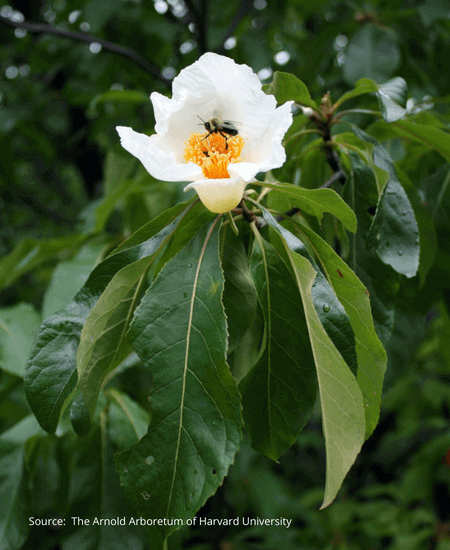
Theaceae, the Tea Family
Franklinia alatamaha is a species that belongs under the plant family, Theaceae. Theaceae is “the tea family.” so what does that mean?
the final 3 levels in scientific classification is Family / Genus / Species. in simply terms (that I need): Theaceae is the grandparents (Family). Franklinia the parent (Genus). Franklinia alatamaha is the child, so to speak (a specific plant — a species).
Theaceae includes species of flowering plants comprising shrubs and trees. species include tea plants that we consume (eg, Green Tea, Camellia sinensis) and ornamental camellias. most Theaceae are evergreen but the not the Franklinia 🙁
Stewartia and Gordonia genera in the Theaceae family. they include plants that look A LOT like the F. alatamaha. The Franklinia is still known as Gordonia pubescens in many European texts (Bartram’s Garden). scientists who performed DNA sequencing found that “The data also support the recognition of Franklinia as distinct although closely related to Gordonia” (NIH / PubMed, Phylogenetic relationships of Theaceae inferred from chloroplast DNA sequence data).
Franklinia Care and Propagation
Franklinia is a specimen tree or large shrub valued for its late summer flowers, good fall color and interesting history. it deserves a prominent location in the landscape (Missouri Botanical Garden).
General Care
DO NOT overwater F. alatamaha. however, she’s not drought tolerant and appreciates water so you must plant her in VERY well draining soil. wilt and root rot can be serious problems. our one small potted plant did well with no care … until I watered her heavily in preparation for planting. planting was delayed 10 days and by then, she was wilted. her outcome is pending :/
Franklinia Tea Tree is hard to transplant. so do your best to FIND a good location. it has a “sparsely fibrous root system, and is best left undisturbed once planted in the landscape” (Missouri Botanical Garden).
here’s something i’ve never seen: do not plant where cotton has been grown. there is a pathogen that affects cotton that also affects Franklin trees (NC State Extension).
Soil
Best grown in organically rich soil. add gravel, sand, perlite to the soil and plant on a mound, is my advice. we add 2-3 five-gallon buckets of gravel from our streambed for some plants. Rosemary, Texas Persimmon and Black Goji have gravel stones incorporated into the soil. we’ll do the same for the F. alatamaha we plant.
pH preference is acidic. the National Gardening Association recommends pH values 4.5 to 6.5.
NOT good is compacted clay soil and excessive moisture.
Sun
the online consensus is full sun in northern climates, but provide the F. alatamaha with afternoon shade in hot summer climates.
Patio Plant
Franklinia it makes a great plant for the patio! several credible references write that the Franklinia makes a good patio plant, despite her onerous reputation. “Its stature makes it a good choice for small spaces” (NC State Extension).
HEPPY™ recommends: use VERY loose soil to prevent excessive moisture. also, consider adequate shade because the Franklinia is not drought tolerant.
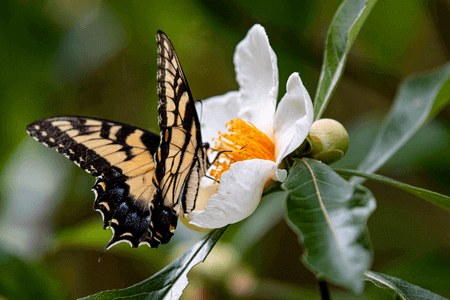
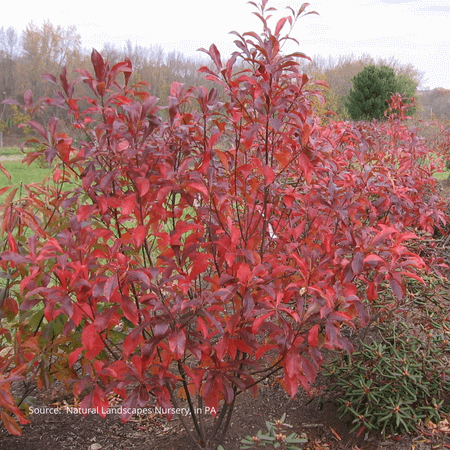
Rapid Healing
a very interesting observation was made by Dr. Hassan Amjad. he mentioned that Franklinia exhibited “rapid healing” when woody branches were injured (eg, the trunk, woody branches).
A seriously unusual history
a picture is worth a thousand words. but in this case, only a few words are needed. the red circle below was her native range in the late 1700’s. the Franklin Tea Tree has a seriously unusual history.
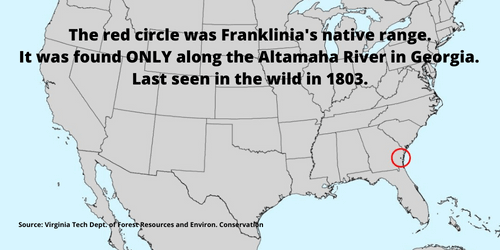
John and William Bartram discovered that “rare and elegant flowering shrub,” F. alatamaha, October 1, 1765. They had lost their way while crossing of the Altamaha River at Fort Barrington in southeast Georgia. William Bartram was the son of John Bartram. both were botanists from Philadelphia, Pennsylvania.
in subsequent years, William Bartram returned several times to the Altamaha River during collecting trip to the American South (1773 through 1776). he brought seed back to Philadelphia in 1777.
1803 as the last time F. alatamaha was seen in the wild, according to many online sources. therefore, William Bartram MAY HAVE harvested the last native F. alatamaha seeds.
call it dumb luck, very sharp botanical skills, or a little of both, all current trees are cultivated plants derived from the original seeds brought to Philadelphia by William Bartram.
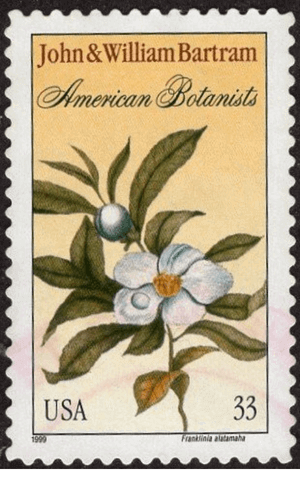
Why extinct in the wild?
overcollection by plant collectors, and fungal disease introduced with the cultivation of cotton plants.
New Genus and Species
William Bartram studied the plant for several years of study. there was nothing like it! so William classified it to a new genus Franklinia! how does someone know what plant is unique in the world? not sure. it is amazing that plants were so well know in those times.
the species name, alatamaha is named after the Altamaha River, where she was discovered.
Why the name?
John Bartram died in September 22, 1777. I believe that fully, or partly influenced William Bartram to name the Genus in honor of his father’s friend Benjamin Franklin. to this day, Franklin Tree is commonly used to describe F. alatamaha (in North America).
Franklinia growing at HEPPY™
We're still trying ....
DON’T OVERWATER these girls like the dummy you see to the right!
yup, just days before planting I gave our potted girl and good soaking. after all, she’d been in the pot for almost a year until I created the ideal planting location!
she survived deer grazing, winter, and chilled at HEPPTY™ for a year but just before planting … I overwatered! the other issue was that I took about a week after watering her before planting. she declined quickly; she was toast by the time I went to plant her.
we’re a no BS operation and I describe the plant, my mistake and show the plant in this YouTube vid.
References
Bartram’s Garden, Franklinia Series: Finding F. alatamaha
Lady Bird Johnson Wildflower Center
Missouri Botanical Garden: F. alatamaha
National Gardening Association: Franklin Tree
Natural Landscapes Nursery, Franklin Tree
NC State University, NC State Extension
US Forest Service, How Are Rare Plants Conserved?
Virginia Tech Dept. of Forest Resources and Environmental Conservation
